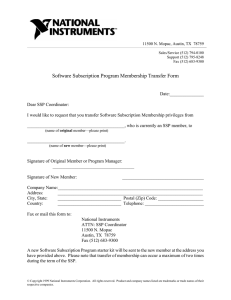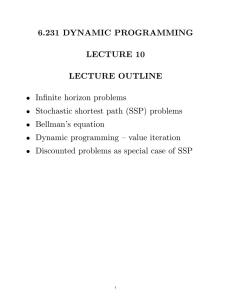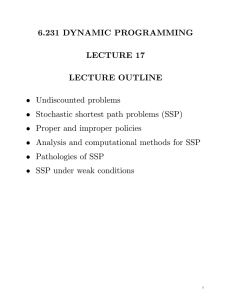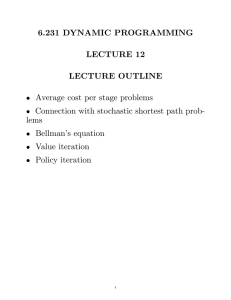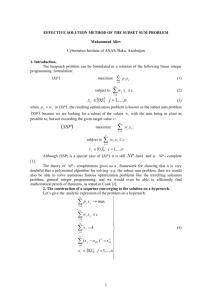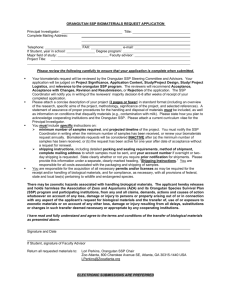6.231 DYNAMIC PROGRAMMING LECTURE 18 LECTURE OUTLINE • Undiscounted total cost problems
advertisement
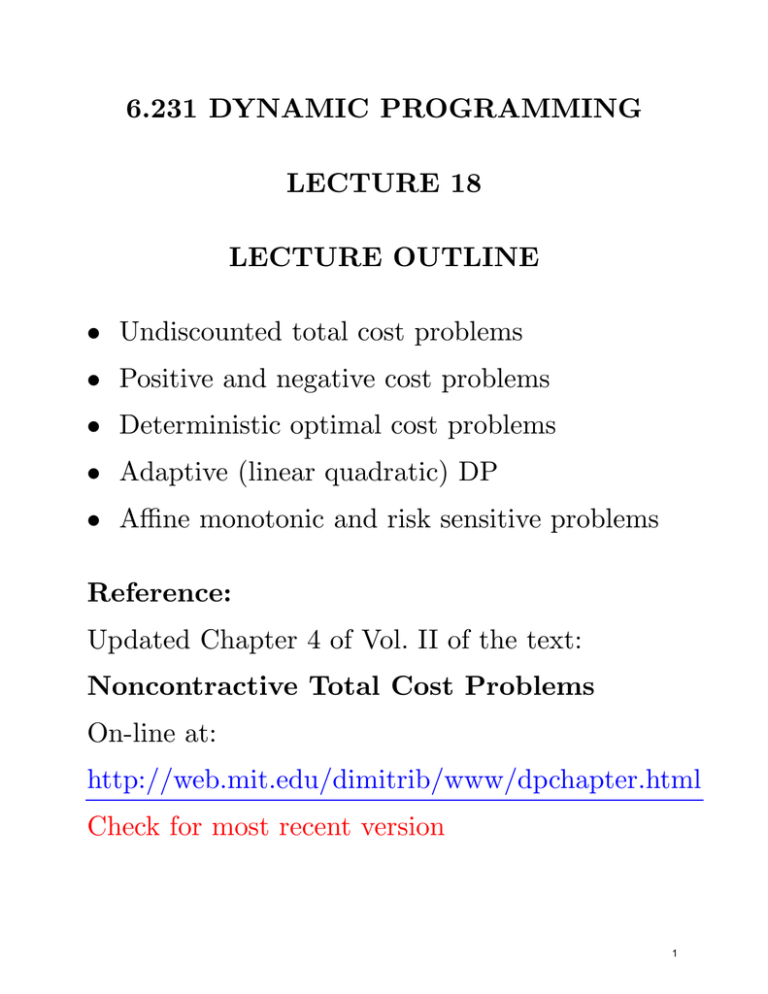
6.231 DYNAMIC PROGRAMMING
LECTURE 18
LECTURE OUTLINE
• Undiscounted total cost problems
• Positive and negative cost problems
• Deterministic optimal cost problems
• Adaptive (linear quadratic) DP
• Affine monotonic and risk sensitive problems
Reference:
Updated Chapter 4 of Vol. II of the text:
Noncontractive Total Cost Problems
On-line at:
http://web.mit.edu/dimitrib/www/dpchapter.html
Check for most recent version
1
CONTRACTIVE/SEMICONTRACTIVE PROBLEMS
• Infinite horizon total cost DP theory divides in
− “Easy” problems where the results one expects hold (uniqueness of solution of Bellman Eq., convergence of PI and VI, etc)
− “Difficult” problems where one of more of
these results do not hold
• “Easy” problems are characterized by the presence of strong contraction properties in the associated algorithmic maps T and Tµ
• A typical example of an “easy” problem is discounted problems with bounded cost per stage
(Chs. 1 and 2 of Voll. II) and some with unbounded
cost per stage (Section 1.5 of Voll. II)
• Another is semicontractive problems, where Tµ
is a contraction for some µ but is not for other
µ, and assumptions are imposed that exclude the
“ill-behaved” µ from optimality
• A typical example is SSP where the improper
policies are assumed to have infinite cost for some
initial states (Chapter 3 of Vol. II)
• In this lecture we go into “difficult” problems
2
UNDISCOUNTED TOTAL COST PROBLEMS
• Beyond problems with strong contraction properties. One or more of the following hold:
− No termination state assumed
− Infinite state and control spaces
− Either no discounting, or discounting and
unbounded cost per stage
− Risk-sensitivity/exotic cost functions (e.g.,
SSP problems with exponentiated cost)
• Important classes of problems
− SSP under weak conditions (e.g., the previous lecture)
− Positive cost problems (control/regulation,
robotics, inventory control)
− Negative cost problems (maximization of positive rewards - investment, gambling, finance)
− Deterministic positive cost problems - Adaptive DP
− A variety of infinite-state problems in queueing, optimal stopping, etc
− Affine monotonic and risk-sensitive problems
(a generalization of SSP)
3
POS. AND NEG. COST - FORMULATION
• System xk+1 = f (xk , uk , wk ) and cost
Jπ (x0 ) = lim
E
wk
N →∞
k=0,1,...
(N −1
X
αk g
xk , µk (xk ), wk
k=0
)
Discount factor α ∈ (0, 1], but g may be unbounded
• Case P: g(x, u, w) ≥ 0 for all (x, u, w)
• Case N: g(x, u, w) ≤ 0 for all (x, u, w)
• Summary of analytical results:
− Many of the strong results for discounted
and SSP problems fail
− Analysis more complex; need to allow for Jπ
and J * to take values +∞ (under P) or −∞
(under N)
− However, J * is a solution of Bellman’s Eq.
(typically nonunique)
− Opt. conditions: µ is optimal if and only if
Tµ J * = T J * (P) or if Tµ Jµ = T Jµ (N)
4
SUMMARY OF ALGORITHMIC RESULTS
• Neither VI nor PI are guaranteed to work
• Behavior of VI
− P: T k J → J * for all J with 0 ≤ J ≤ J * , if
U (x) is finite (or compact plus more conditions - see the text)
− N: T k J → J * for all J with J * ≤ J ≤ 0
• Behavior of PI
− P: Jµk is monotonically nonincreasing but
may get stuck at a nonoptimal policy
− N: Jµk may oscillate (but an optimistic form
of PI converges to J * - see the text)
• These anomalies may be mitigated to a greater
or lesser extent by exploiting special structure, e.g.
− Presence of a termination state
− Proper/improper policy structure in SSP
• Finite-state problems under P can be transformed to equivalent SSP problems by merging
(with a simple algorithm) all states x with J * (x) =
0 into a termination state. They can then be
solved using the powerful SSP methodology (see
updated Ch. 4, Section 4.1.4)
5
EXAMPLE FROM THE PREVIOUS LECTURE
• This is essentially a shortest path example with
termination state t
u′ , Cost 0
tbc
Cost 0
2
u, Cost b
1
a
t
12
2
J(t)
b
J(t)
(1)
Case P Case N
(1)
Case P Case N
Bellman Eq.
Bellman Eq.
Solutions Solutions
Solutions Solutions
Bellman Eq.
Bellman Eq.
0)
Jµ′ = (0, 0)
Jµ′ = J * = (0, 0)
Jµ = (b, 0)
0)
Jµ = J * = (b, 0)
J(1)
0)
0)
Case P
t) startingCase
VI fails
fromN
J(1) = 0, J(t) = 0
PI ! stops at µ
J(1)
0)
Case N
) Case
P starting from
VI fails
J(1) < J ∗ (1), J(t) = 0
PI oscilllates between µ and µ′
µ
• Bellman Equation:
J(1) = min J(1), b + J(t)],
J(t) = J(t)
6
DETERM. OPT. CONTROL - FORMULATION
• System: xk+1 = f (xk , uk ), arbitrary state and
control spaces X and U
• Cost positivity: 0 ≤ g(x, u), ∀ x ∈ X, u ∈ U (x)
• No discounting:
Jπ (x0 ) = lim
N →∞
N
−1
X
k=0
g xk , µk (xk )
• “Goal set of states” X0
− All x ∈ X0 are cost-free and absorbing
• A shortest path-type problem, but with possibly
infinite number of states
• A common formulation of control/regulation
and planning/robotics problems
• Example: Linear system, quadratic cost (possibly with state and control constraints), X0 = {0}
or X0 is a small set around 0
• Strong analytical and computational results
7
DETERM. OPT. CONTROL - ANALYSIS
• Bellman’s Eq. holds (for not only this problem,
but also all deterministic total cost problems)
*
*
J (x) = min g(x, u)+J f (x, u) , ∀ x ∈ X
u∈U (x)
• Definition: A policy π terminates starting from
x if the state sequence {xk } generated starting
from x0 = x and using π reaches X0 in finite time,
i.e., satisfies xk̄ ∈ X0 for some index k¯
• Assumptions: The cost structure is such that
− J * (x) > 0, ∀ x ∈
/ X0 (termination incentive)
− For every x with J * (x) < ∞ and every ǫ > 0,
there exists a policy π that terminates starting from x and satisfies Jπ (x) ≤ J * (x) + ǫ.
• Uniqueness of solution of Bellman’s Eq.: J * is
the unique solution within the set
J = J | 0 ≤ J(x) ≤ ∞, ∀ x ∈ X, J(x) = 0, ∀ x ∈ X0
• Counterexamples: Earlier SP problem. Also
linear quadratic problems where the Riccati equation has two solutions (observability not satisfied).
8
DET. OPT. CONTROL - VI/PI CONVERGENCE
• The sequence {T k J} generated by VI starting
from a J ∈ J with J ≥ J * converges to J *
• If in addition U (x) is finite (or compact plus
more conditions - see the text), the sequence {T k J}
generated by VI starting from any function J ∈ J
converges to J *
• A sequence {Jµk } generated by PI satisfies
Jµk (x) ↓ J * (x) for all x ∈ X
• PI counterexample: The earlier SP example
• Optimistic PI algorithm: Generates pairs {Jk , µk }
as follows: Given Jk , we generate µk according to
µk (x)
= arg min g(x, u)+Jk f (x, u) ,
x∈X
u∈U (x)
and obtain Jk+1 with mk ≥ 1 VIs using µk :
mk −1
Jk+1 (x0 ) = Jk (xmk )+
X
t=0
g
xt , µk (xt )
,
x0 ∈ X
If J0 ∈ J and J0 ≥ T J0 , we have Jk ↓ J * .
• Rollout with terminating heuristic (e.g., MPC).
9
LINEAR-QUADRATIC ADAPTIVE CONTROL
• System: xk+1 = Axk +Buk , xk ∈ ℜn , uk ∈ ℜm
P∞
′ Qx + u′ Ru ), Q ≥ 0, R > 0
(x
• Cost:
k
k
k=0 k
k
• Optimal policy is linear: µ∗ (x) = Lx
• The Q-factor of each linear policy µ is quadratic:
x
′
′
Qµ (x, u) = ( x u ) Kµ
(∗)
u
• We will consider A and B unknown
• We use as basis functions all the quadratic functions involving state and control components
xi xj ,
ui uj ,
xi uj ,
∀ i, j
These form the “rows” φ(x, u)′ of a matrix Φ
• The Q-factor Qµ of a linear policy µ can be
exactly represented within the subspace spanned
by the basis functions:
Qµ (x, u) = φ(x, u)′ rµ
where rµ consists of the components of Kµ in (*)
• Key point: Compute rµ by simulation of µ (Qfactor evaluation by simulation, in a PI scheme)
10
PI FOR LINEAR-QUADRATIC PROBLEM
• Policy evaluation: rµ is found (exactly) by least
squares minimization
2
X ′
′
′
′
min
φ(x
,
u
)
r
−
x
Qx
+
u
Ru
+
φ
x
,
µ(x
)
r
k k
k
k
k+1
k+1
k
k
r
(xk ,uk )
where (xk , uk , xk+1 ) are “enough” samples generated by the system or a simulator of the system.
• Policy improvement:
µ(x) ∈ arg min
u
φ(x, u)′ rµ
• Knowledge of A and B is not required
• If the policy evaluation is done exactly, this
becomes exact PI, and convergence to an optimal
policy can be shown
• The basic idea of this example has been generalized and forms the starting point of the field of
adaptive DP
• This field deals with adaptive control of continuousspace (possibly nonlinear) dynamic systems, in
both discrete and continuous time
11
FINITE-STATE AFFINE MONOTONIC PROBLEMS
• Generalization of positive cost finite-state stochastic total cost problems where:
− In place of a transition prob. matrix Pµ , we
have a general matrix Aµ ≥ 0
− In place of 0 terminal cost function, we have
a more general terminal cost function J¯ ≥ 0
• Mappings
Tµ J = bµ + Aµ J,
(T J)(i) = min (Tµ J)(i)
µ∈M
• Cost function of π = {µ0 , µ1 , . . .}
¯
Jπ (i) = lim sup (Tµ0 · · · TµN −1 J)(i),
i = 1, . . . , n
N →∞
• Special case: An SSP with an exponential risksensitive cost, where for all i and u ∈ U (i)
Aij (u) = pij (u)eg(i,u,j) ,
b(i, u) = pit (u)eg(i,u,t)
• Interpretation:
Jπ (i) = E {e(length of path of π starting from i) }
12
AFFINE MONOTONIC PROBLEMS: ANALYSIS
• The analysis follows the lines of analysis of SSP
• Key notion (generalizes the notion of a proper
policy in SSP): A policy µ is stable if Akµ → 0; else
it is called unstable
• We have
TµN J = AN
µ J+
N
−1
X
Akµ bµ ,
k=0
∀ J ∈ ℜn , N = 1, 2, . . . ,
• For a stable policy µ, we have for all J ∈ ℜn
Jµ = lim sup TµN J = lim sup
N →∞
N →∞
∞
X
k=0
Akµ bµ = (I −Aµ )−1 bµ
• Consider the following assumptions:
(1) There exists at least one stable policy
(2) For every unstable
policy µ, at least one comP∞
ponent of k=0 Akµ bµ is equal to ∞
• Under (1) and (2) the strong SSP analytical
and algorithmic theory generalizes
• Under just (1) the weak SSP theory generalizes.
13
MIT OpenCourseWare
http://ocw.mit.edu
6.231 Dynamic Programming and Stochastic Control
Fall 2015
For information about citing these materials or our Terms of Use, visit: http://ocw.mit.edu/terms.
